Italy’s motorcycle industry is on a roll right now. Ducati has just won the MotoGP title, Aprilia’s bikes have been impressing on road and track, and Moto Guzzi has launched its first liquid-cooled V-twin, the V100 Mandello. Recently troubled marques Benelli, Bimota, Fantic and Mondial have been revived and are building exciting machines.
But one old favourite remains abandoned and ignored, more than four decades after it was famed for producing arguably the world’s fastest and most glamorous superbike. Laverda was a small firm from Breganze, near Vicenza in Italy’s north-east. Its flagship was the mighty Jota, a 981cc triple that combined handsome looks with all-conquering performance and an unruly reputation.

A reputation that was well deserved, on the evidence of a blast on this particular example, resplendent in the company’s favoured orange paintwork. My charge along traffic-free Suffolk country lanes was exhilarating; the sort of ride that forged the Jota legend.
Whenever I wound open the throttle, the result was fierce acceleration, hand-numbing vibration through the low clip-on bars, and a howling three-cylinder soundtrack from the exhaust. Through the bends, the Laverda’s firm ride shook my kidneys and sometimes made me feel as though I was trying to hang onto an uncontrollable wild animal.
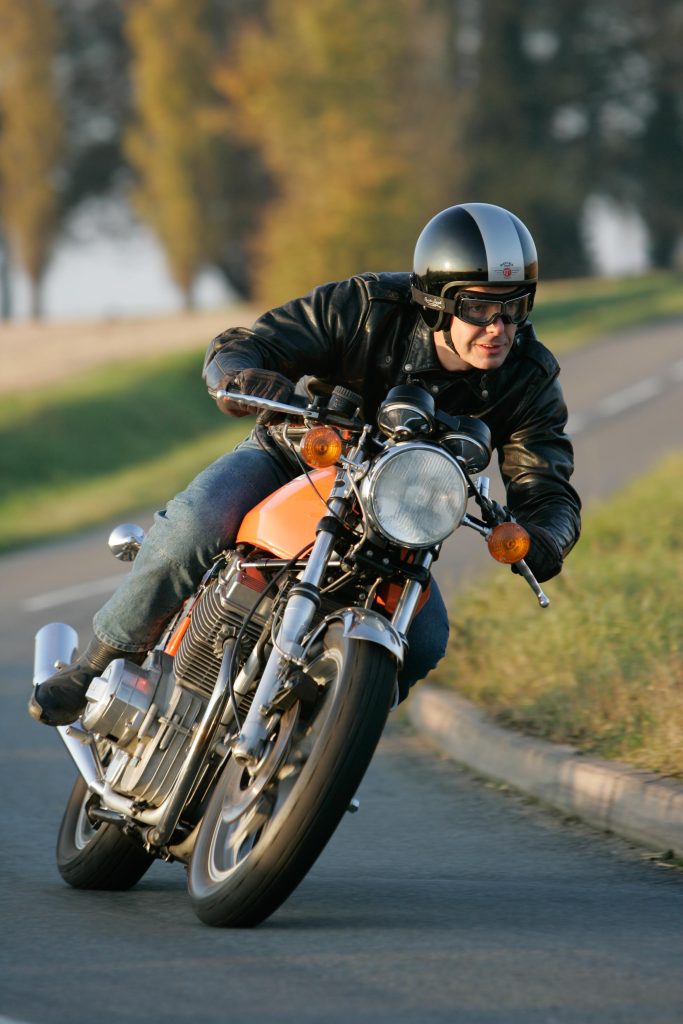
That image of brutal power accompanied by marginal handling helped make Jota one of the iconic superbikes of the Seventies. It was certainly one of the fastest. With a top speed of 140mph, it had a strong claim to have displaced Kawasaki’s Z1000 as the king of the road following its launch in 1976.
And there was much more to the Jota than merely speed. It combined Italian character, design flair and chassis rigidity with ruggedness and reasonable sophistication. And it was born not in Breganze but in Herefordshire – by brothers Richard and Roger Slater, Laverda’s UK importers.
The Slaters were going production racing with Laverda’s 3CL triple, and tuned its double-overhead cam, aircooled engine with high-lift camshafts and high-compression pistons, as used by the factory’s endurance racers. Free-breathing pipes helped raise power output to 90bhp at 8000rpm. The brothers offered the tuned triple as a fresh model that they named the Jota, after a Spanish dance in three-four time.
Its impact was spectacular. The Jota’s new-found power made it unbeatable in a straight line. And although the big Laverda required plenty of muscle to change direction, and could weave at high speed, its reasonably stiff frame and taut suspension gave very competitive cornering performance.
That was confirmed on the racetrack, where the Slaters’ rider, Peter “PK” Davies, wrestled a Jota to three National production race championships in the late Seventies. The Jota sold well in the UK too, despite its high price, prompting the Laverda factory to produce a similar model for other markets including the US.
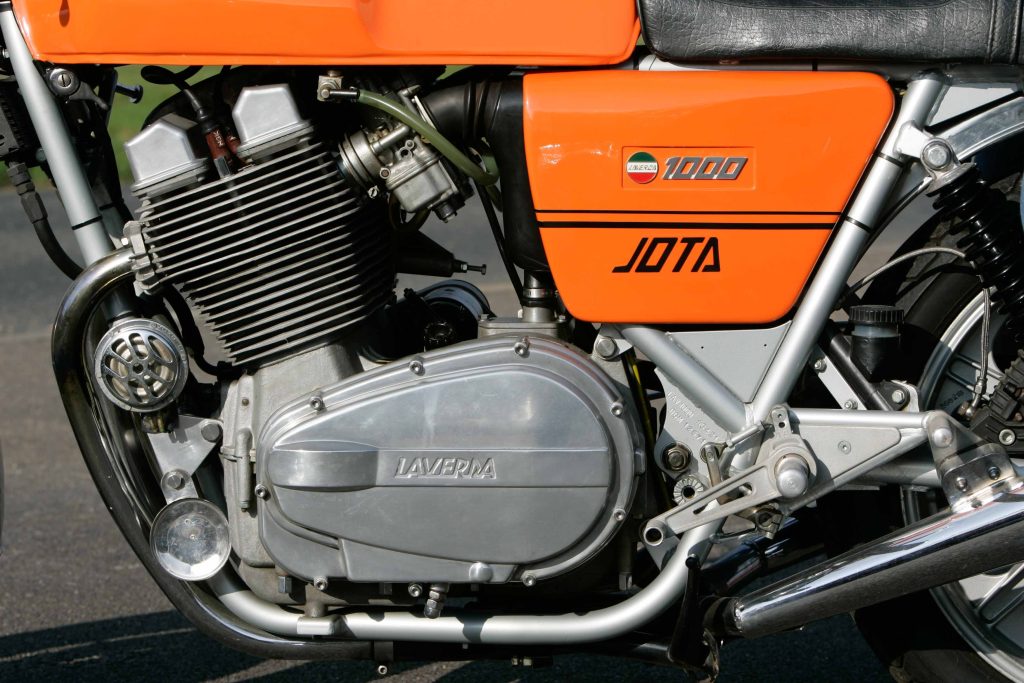
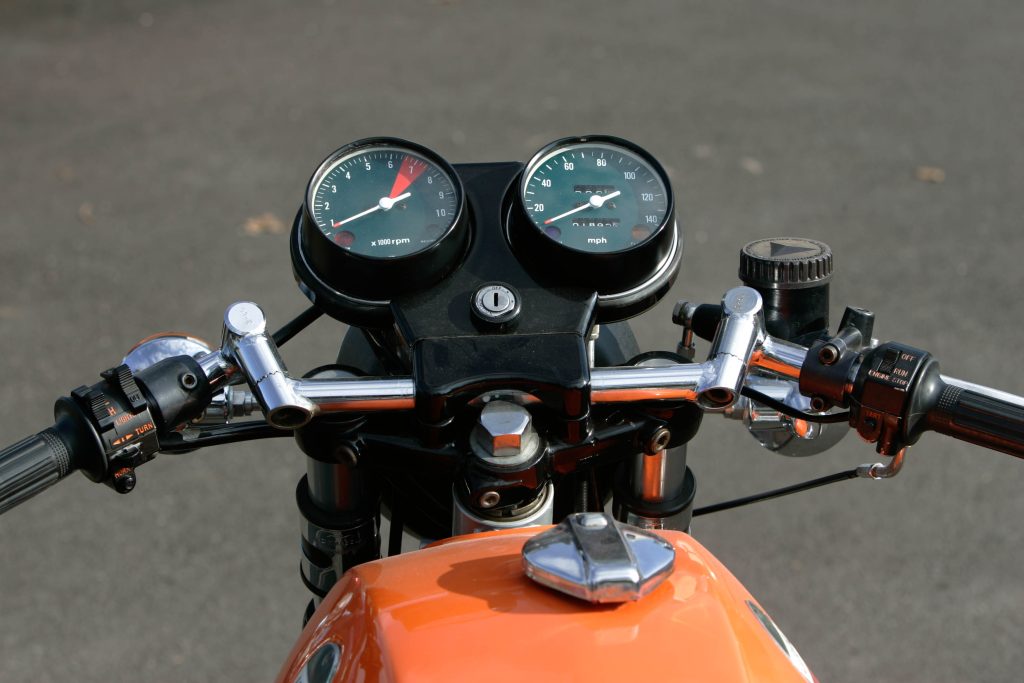
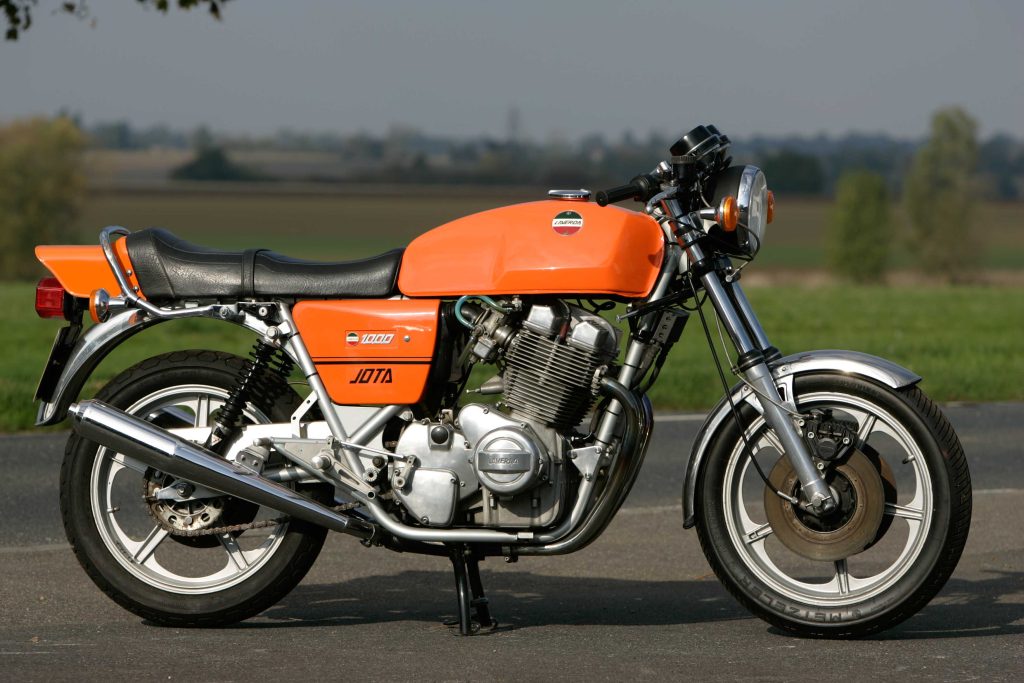
The Jota’s reputation for wildness was exaggerated; previous examples I’ve ridden have been more rider-friendly than this gorgeous but not fully sorted example. That said, the triple was certainly best suited to riders physically big and strong enough to cope with its stretched-out riding position, tall seat and hefty wet weight of 237kg.
That potent twin-cam motor was always the Jota’s main attraction, the key to both its speed and its barrel-chested look. That was certainly true of this very clean machine, borrowed from classic dealership Made in Italy. First registered in 1980, it made do without the half-fairing that the model often wore by that time.
The powerplant fully lived up to expectations, too. It started at the press of the button (Laverdas, with their partly Japanese electrics, were generally among the more dependable of Italian bikes), burbling a rich three-pot sound through its minimally silenced pipes. For a tuned motor it ran reasonably well at low revs, responding respectably cleanly through its bank of Dell’Orto carburettors.
As the revs rose towards the 8000rpm redline the Jota came alive, storming forward with an exhilarating, high-pitched howl and with a force that made me grip those juddering clip-ons tightly. In a straight line the Laverda was magical. Its sheer speed and presence more than made up for a raw, almost crude feel that brought to mind the company’s background as a maker of agricultural machinery.
Corners weren’t quite so much fun. Smooth main-road curves were fine but on country lanes the Laverda was a handful despite its thoughtfully added steering damper. Its Koni shocks were very firm despite being on their lowest preload settings – to give them as much travel as possible – and over some bumps had me wondering whether I was about to punch a Jota-sized hole in a roadside hedge.
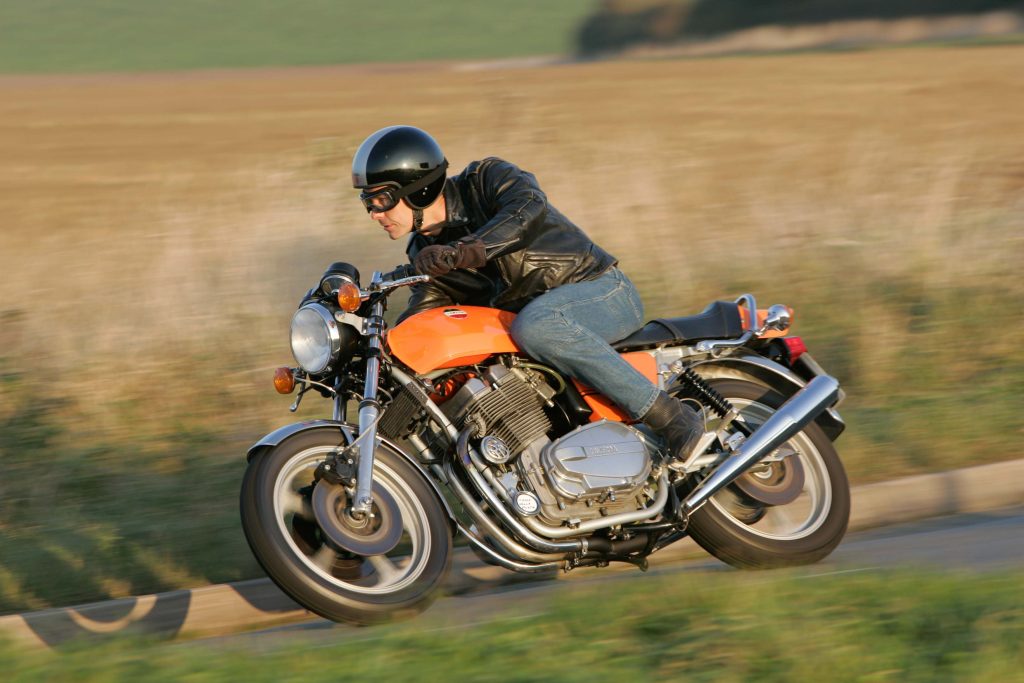
Thankfully the excellent brakes prevented that happening. The triple Brembo discs, plumbed with braided hose, lived up to the Italian specialist’s reputation. The Metzeler tyres provided plenty of grip, too, though I didn’t manage to ground an engine cover, as can happen when the big triple is cornered very hard.
Laverda later improved the Jota’s ground clearance with an updated engine, and even reduced its vibration with a smoother-running 120-degree (instead of 180-degree, with two pistons up and one down) crankshaft. But the small firm struggled to meet tightening emissions regulations, and suffered a series of financial crises and comebacks before finally disappearing from the scene two decades ago.
Current owners Piaggio show no sign of adding Laverda to the list of reborn Italian marques, but the Jota legend endures – as it surely will for as long as thunderous triples like this one are ridden. I finished my blast having enjoyed a bike that was gloriously fast, loud and aggressive, albeit requiring some chassis fine-tuning in order to approach its full magnificence.
Given that many classic superbikes inevitably fail to live up to their reputations, perhaps it was no bad thing to find a machine that matched its hairy image. If riding this Jota was a bit scary at times, it was also one hell of a thrill.
1980 Laverda Jota
You’ll love: Arm-stretching speed, spine-tingling sound
You’ll curse: Palm-blistering vibes, back-straining weight
Buy it because: More of a Seventies legend than Don Corleone
Condition and price range: Project: £10,000 Nice ride: £14,000 Showing off: £18,000
Engine: Aircooled DOHC triple
Capacity: 981cc
Maximum power: 90bhp @ 8000rpm
Weight: 237kg with fluids
Top speed: 140mph
Read more
With a starring role in Top Gun, the Kawasaki Ninja became a blockbuster
A war-time relic, riding Harley Davidson’s WL45 calls for a cool head
Rudge match: The ins and outs of owning a pioneer motorcycle



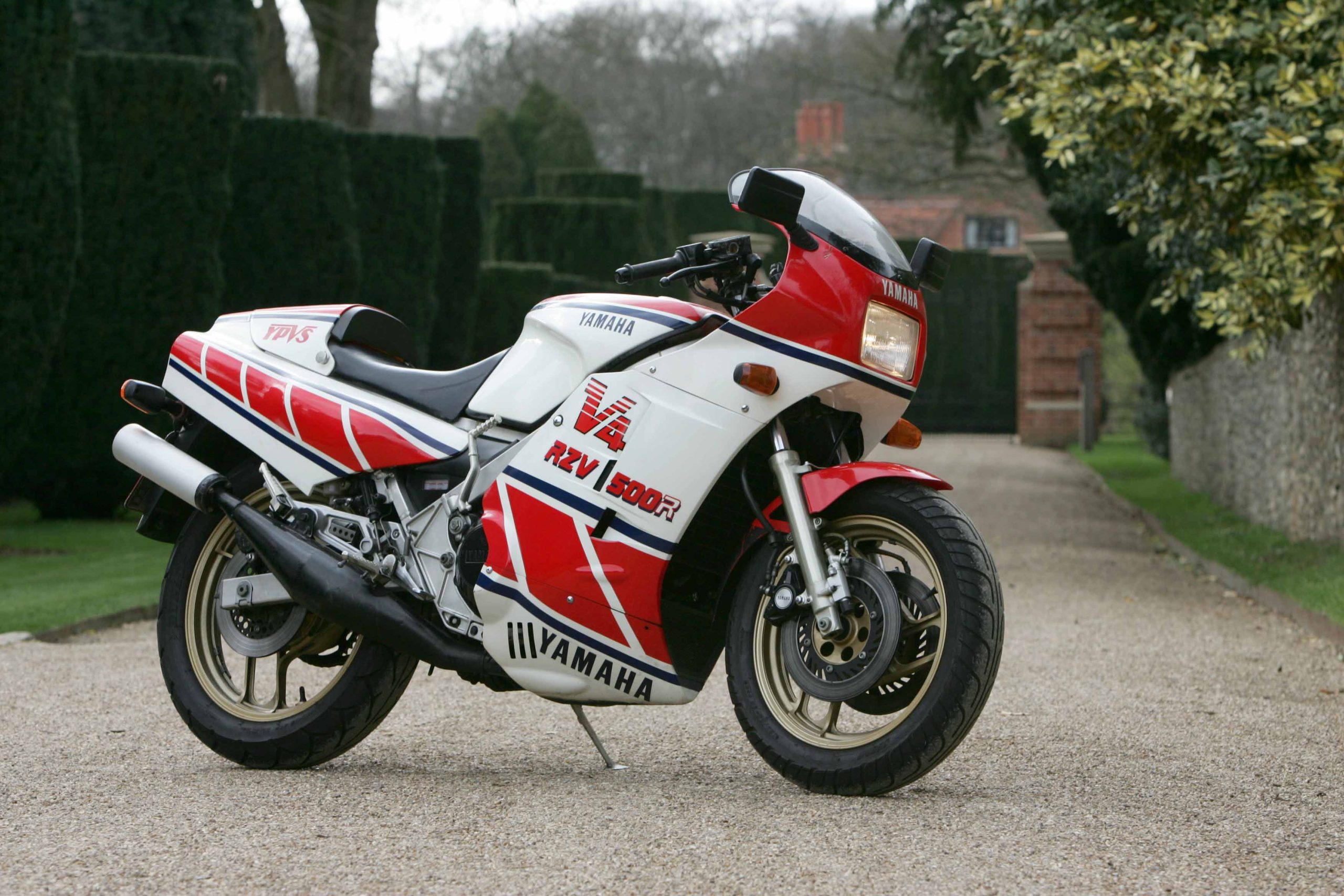






Bad handlebar vibration means there is something wrong.Slaters started racing a 3C (spoked wheels rear drum) this haf factory endurance race parts fitted as was Uk marketed as the 3CE ( E for England) the Jota with cast wheels and 3 discs, came later.All Jotas pre 80 were without fairing,All Jotas post 81 were eith fairing.Steering damper is not stock and should not be needed except,maybe, fir IOM racing.Koni shocks are not stock and probably out of correct settings,Marzochi are stock, I once asked Massimo Laverda why they did mot use Koni shocks and he told me it was because Koni do not make front forks
A very good friend of mine, Dave Skinner proddy raced one of these beasts, it was possably one of the tuned versions, looked a beadt he also had a ducati 500 twin, that was tuned, later he raced a Morowiki 998 kawasaki , that also was a beast, 140 hp on the dyno.
Great bikes, dave was a superb engine builder, and a, thoroughly nice guy.
I owned one of the last SFC 1000s from the factory . It was a formidable beast but did not have any of the unruly handling as described above .It was fast (very) reliable and comfortable and was set up for my 160lb 6ft frame . Wish I still had it !!!
I wonder how it would have handled with a rear tyre at the right pressure?
Great Spot!!
Firstly, lowering the preload primarily affects ride height. Stiffness in the shocks is due to over-firm compression damping.
Secondly, never had my brother’s early Jota weave, even near maximum speed.
There is no better sound than a triple, and the Jota is top of the pile IMHO.
First thing I noticed was the rear tyre. Always check your tyre pressures.
I sold bikes for thirty years and customers would often arrive on their litre bikes with 10psi
in the tyres.
Owned one for years great sounding beast heavy clutch exhilarating to ride like being married to Sophie Lauren treat her right your be ok treat her wrong hm well loads of character wild handling tire pressures performs great if you set them right who Jane fonda you can have a better work out on the laverda
I owned a Jota 120 from new (Fowler’s Motorcycles, Bristol April 1982) and can’t recall just why I sold it ‘cos I’ve regretted it every day since. I believe around 465 120’s were built. I’d love another one but would have to be mint — support/maintenance/spares a big issue. Having read lots on Jota’s 180 / 120 etc, & ridden mine for 1,000’s of miles it’s the only bike of 10 I’ve owned that made the biggest positive impression. I believe the 120 rather than the 180 is the most refined & sorted of the Jota range — except for the SFC1000 Special perhaps!
I owned a Laverda 3C 1976-1978 & a Laverda Jota 180 (gold) from 1978. Both bikes had the same characteristics, in my experience they took 10,000 miles to run in properly then all vibration issues were smoothed out. Both were beautiful bikes, drew a crowd wherever I parked & I miss them dearly.
Hi,
Could you please tell me if these vin #s are 3c or jota units.
They are registered in the USA.
1976 # 3600
1976 # 3474
1975 # 2344
Cheers tim.